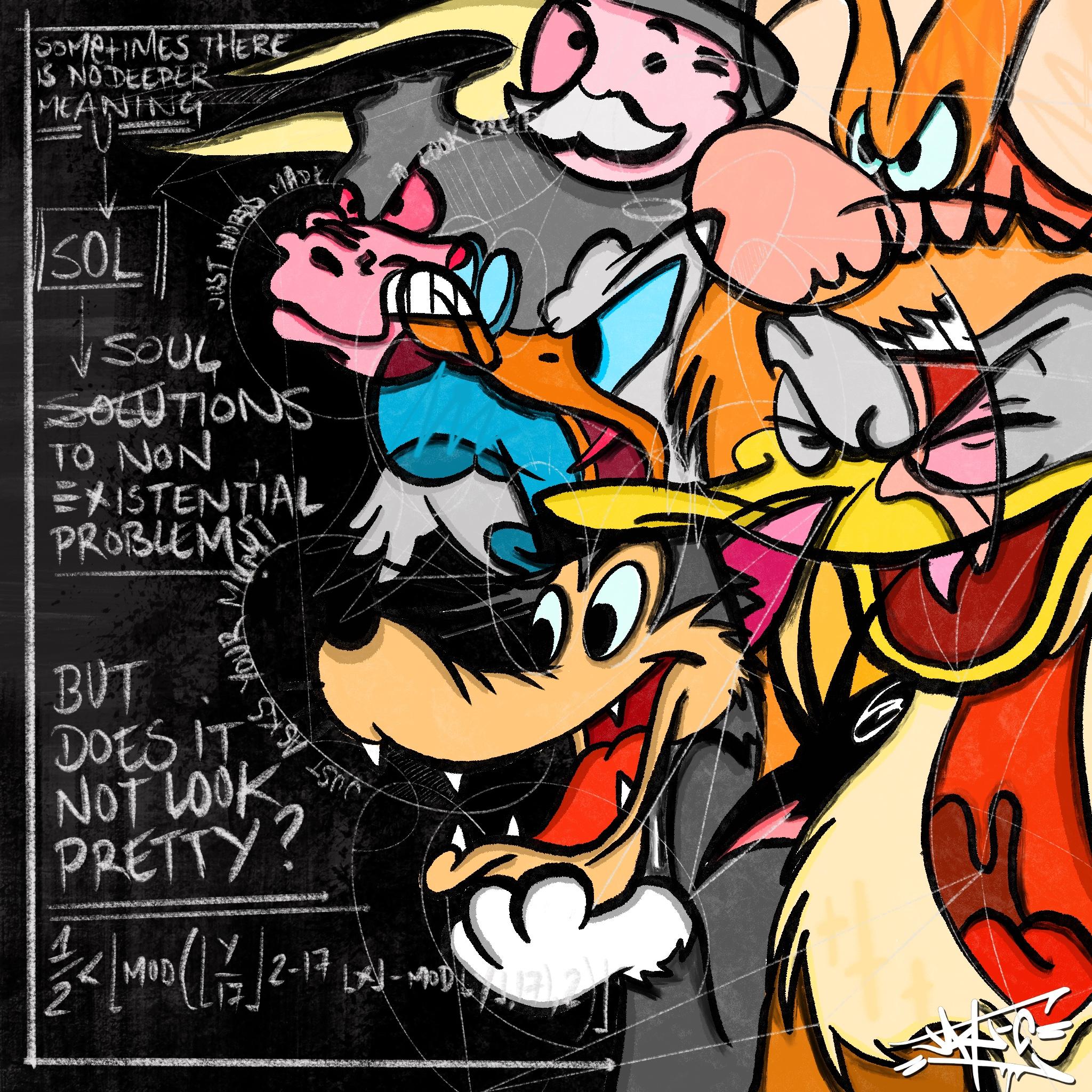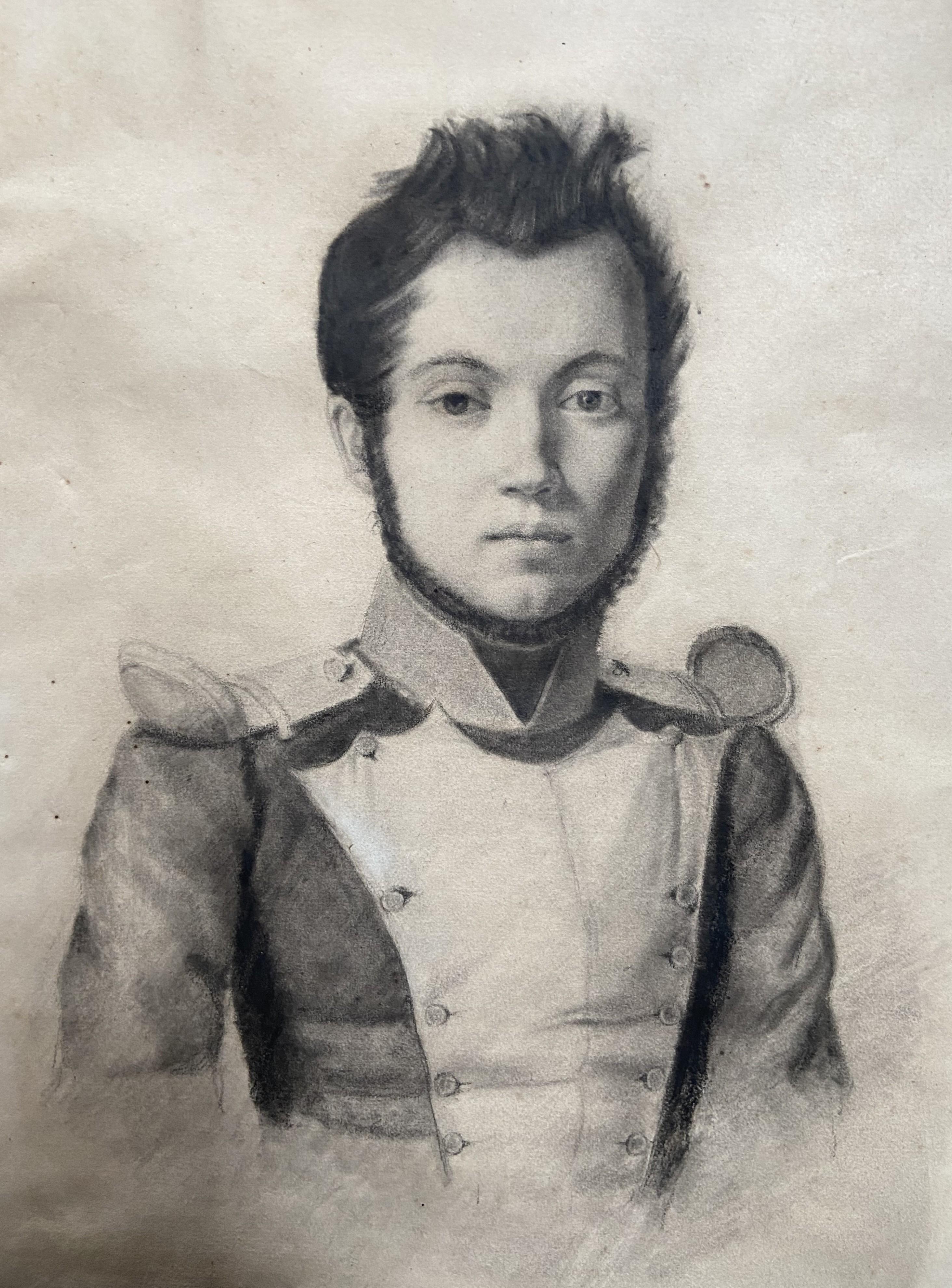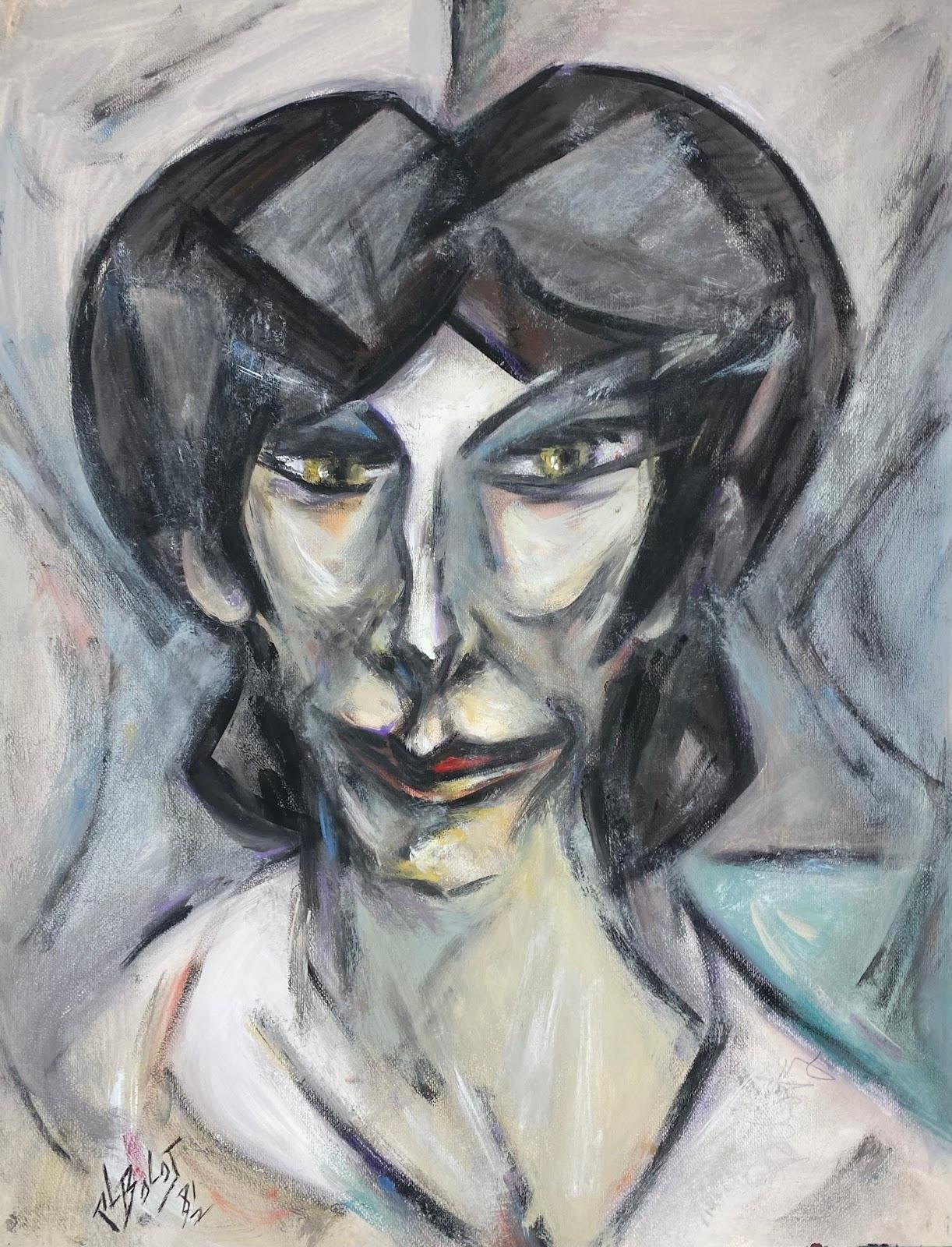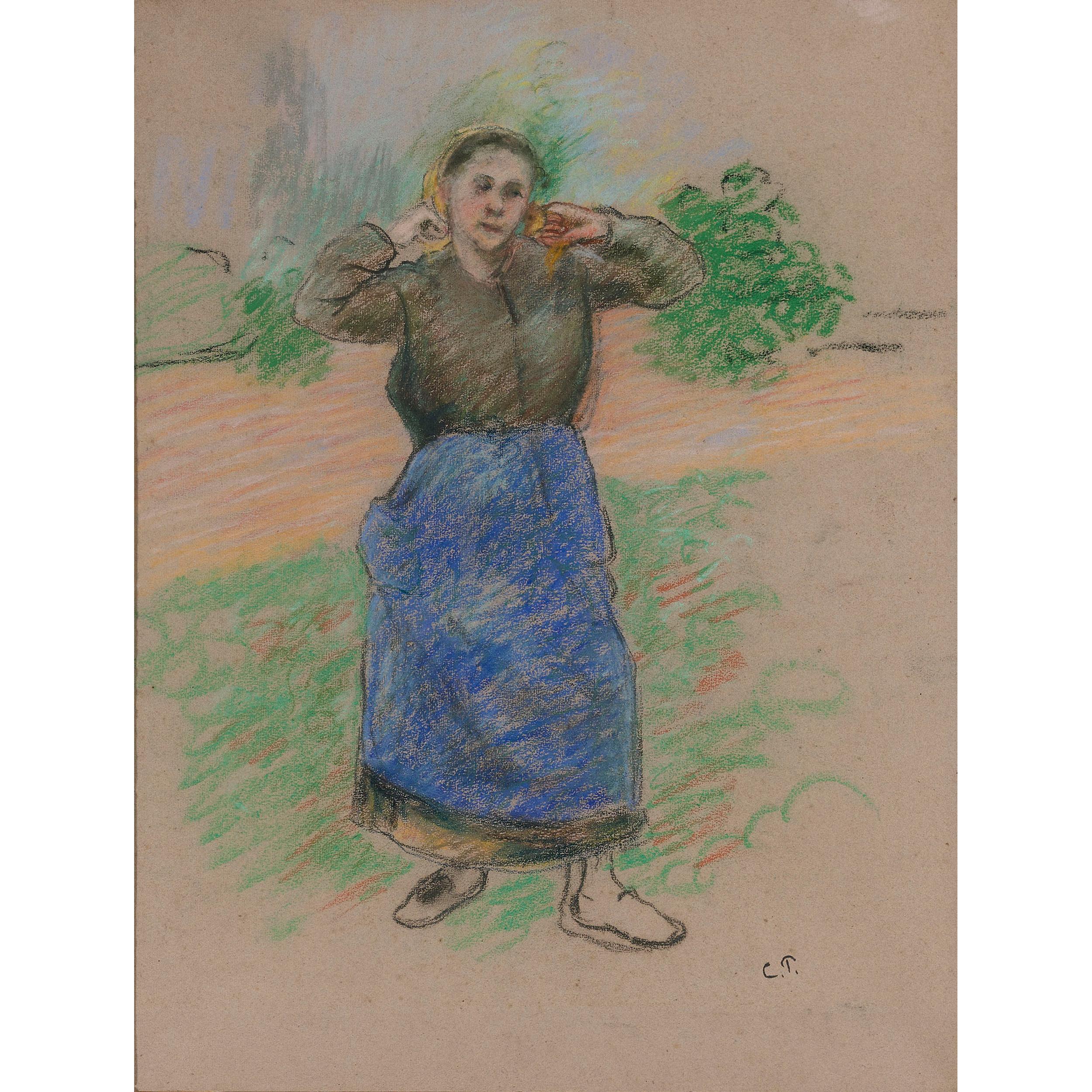Items Similar to Costume of an envoy of Venice, a drawing by Francesco Galimberti (1755 - 1803)
Want more images or videos?
Request additional images or videos from the seller
1 of 8
Francesco Galimberti Costume of an envoy of Venice, a drawing by Francesco Galimberti (1755 - 1803)ca. 1780
ca. 1780
About the Item
We thank Mrs. Bożena Anna Kowalczyk who suggested the attribution to Francesco Galimberti based on a photograph of the artwork.
This engaging drawing, finely executed in black and red chalks, depicts a Venetian diplomat in his 'new clothes'. Probably intended for engraving, this drawing is a touching testimony to the work of Francesco Galimberti, an artist active in Venice at the end of the 18th century, and a reminder of the pomp of the Venetian Republic in its twilight years.
1. Francesco Galimberti, a little-known Venetian painter and engraver
Information about the life and work of Francesco Galimberti is rather scarce. According to De Boni (1840), he was born in Venice in 1755; and Moschini (ca. 1830, p. 140) mentions him among the disciples of Gian Battista Tiepolo. His known works, however, do not confirm a particular influence of the great Venetian master; in an attempt to break with the tradition of Venetian painting, they could rather be compared with those of Pietro Longhi.
Two portraits of Marcantonio Michiel, one of his main patrons, survive today: one is in the Ca' Rezzonico and the other in a private Italian collection.
In addition to his work as a painter and portraitist, Galimberti, who was also an engraver, is best known today for the many drawings he made for engravings. Around 1778 he made a lasting connection with the engraver Giovanni De Pian (b. 1764), who engraved most of his works, such as the portrait of General Suvorov painted by Galimberti in 1794. Galimberti provided his partner with drawings that the latter translated into engravings. They thus participated together in the publication of the Fasti veneziani in 1796-1797, where De Pian reproduced three drawings supplied by Galimberti. From May to October 1797, they worked together to support the short-lived democratic government that governed the city. The end of Venetian independence led them to take refuge in Vienna where they continued their collaboration until De Pian's death in 1800.
2. Description and related artwork
An elegantly dressed man, depicted in three-quarter view, wears French breeches and a long coat with a richly embroidered edge from which emerges the hilt of a sword carried on his left flank. He is quite youthful in appearance. He has a long, finely curled wig and holds a pair of gloves in his right hand.
The interior in which our model is standing is briefly described: a floor made of large stone slabs, a window on his left partly obscured by a curtain, a few steps in front of the window, a dado running along the wall. This elegant sobriety focuses the viewer's attention on the figure, whose clothes, as described in detail in the instructions, are in fact the real subject of this drawing: the costume of a Venetian Ambassador.
A very similar drawing, also executed in red and black chalks, depicting a Spanish lady, this time in a courtyard is currently in the New York art market.
It is possible that Galimberti was planning to publish a collection of costumes, but we have not found any evidence of engravings based on these works.
3. Framing
This drawing is presented in an antique gilded wooden stick frame.
Main bibliographical references :
G.A. Moschini, Dell'incisione in Venezia (1830 circa), Venezia s.d. (1924), ad indicem
F. De Boni, Biografia di artisti, Venezia 1840, p. 397
- Creator:Francesco Galimberti (1755 - 1803, Italian)
- Creation Year:ca. 1780
- Dimensions:Height: 9.88 in (25.1 cm)Width: 7.63 in (19.39 cm)
- Medium:
- Movement & Style:
- Period:1780-1789
- Condition:Black and red chalks 9 7/8’’x 7 5/8’’ (250 x 193 mm), framed 14 ¾’’ x 11 3/8’’ (37.5 x 29 cm) Provenance: unidentified mark on the right (Lugt 5163); anonymous collector’s mark (Lugt 3038) on the left.
- Gallery Location:PARIS, FR
- Reference Number:1stDibs: LU1568211442282
About the Seller
5.0
Vetted Seller
These experienced sellers undergo a comprehensive evaluation by our team of in-house experts.
Established in 2020
1stDibs seller since 2021
8 sales on 1stDibs
Typical response time: 2 hours
- ShippingRetrieving quote...Ships From: PARIS, France
- Return PolicyA return for this item may be initiated within 3 days of delivery.
More From This SellerView All
- Portrait of a Newlywed by Casper Casteleyn, an artist of the Dutch Golden AgeLocated in PARIS, FRThis marvelous portrait on vellum is the work of a rare Dutch Golden Age artist, Casper Casteleyn, who has also drawn a closely related portrait now at the Fondation Custodia in Pari...Category
17th Century Old Masters Portrait Drawings and Watercolors
MaterialsChalk, Vellum
- The Arab Butcher, a preparatory drawing by Gustave Guillaumet (1840 - 1887)Located in PARIS, FRThis intensely expressive figure is a preparatory study for "Arab Market on the Tocria Plain", a painting exhibited at the 1865 Salon and now in the Musée des Beaux-Arts in Lille. 1...Category
1860s Old Masters Figurative Drawings and Watercolors
MaterialsChalk, Carbon Pencil
- Portrait of a Lady, Drawing Signed and Dated by Augustin de Saint-AubinBy Augustin de Saint-AubinLocated in PARIS, FRThis drawing full of freshness presents us with the profile of an elegant lady, drawn by Augustin de Saint-Aubin on a beautiful summer day in 1776, during the early months of Louis X...Category
1770s Old Masters Portrait Drawings and Watercolors
MaterialsPastel, Pencil
- Christ before Herod, a drawing from the School of TitianLocated in PARIS, FRThis vigorous drawing is clearly inspired by the numerous compositions on the Ecce Homo theme which were produced by Titian and his workshop at the painter's maturity. However, the number of characters and their expressionist treatment, the many variations to Titian's paintings reveal a drawing made by an original artist, perhaps of foreign origin, belonging to the peripheral circle of the "Titian solar system”, as described by the art historian Enrico Maria del Pozzolo. 1. Titian, the leading artist of 16th century Venetian painting and his botteghe Tiziano Vecelli (or Vecellio), known as Titian, was born between 1489 and 1490 in Pieve di Cadore in the Veneto region of Italy into a wealthy family of soldiers and lawyers. At the age of 15, he joined the studio of Giovanni Bellini, where he became friend with Giorgione, ten years his senior. Giorgione introduced him to a new pictorial style in which forms are defined by colour and pictorial substance, freeing himself from the meticulous underlying drawings characteristic of Bellini's painting. Titian became the official painter of the Republic of Venice upon Bellini's death in 1516. In 1518, the completion of his Assumption for the church of Santa Maria Gloriosa dei Frari in Venice established his reputation as the leading painter of the Venetian school: throughout his career, Titian had a considerable impact on other artists of his time, whether they were direct collaborators, occasional contributors, or other artists under his influence. Considered one of the greatest portraitists of his time, his fame spread throughout Europe and he became the official painter of the greatest European families: the Gonzagas, the Farneses (Alessandro Farnese, of whom he executed several portraits, was elected pope in 1534 under the name of Paul III), the Habsburgs (he went to Augsburg in 1548 to paint the portrait of Charles V and King Philip II of Spain, his successor, later became the artist's main patron). As Titian almost reached the age of 90 years, he saw during his lifetime the death of many of his loved ones (his wife Cecilia, his brother Francesco and his son Orazio). A pathetic feeling appears in his late artworks, such as his famous Pieta, his last work intended to decorate his tomb which remained unfinished. Titian's success was also based on the establishment of a large and versatile workshop, which, alongside the traditional assistance in the production of certain paintings, ensured the publication of numerous woodcuts, allowing the master's works to be widely distributed. Long ignored by art historians, the individual stories of these various collaborators, the organisation of this workshop and the interactions of the collaborators with the master are at the heart of contemporary studies on the artist. 2. A complex composition with expressionist overtones Executed with great virtuosity in black chalk, the composition of our drawing is complex, even slightly confused and probably reflects several phases of execution, if not several hands. The scene is organised around the characters of Christ and an executioner wearing a Phrygian cap. Christ is presented at mid-body, slightly at an angle, his torso bare, his shoulders draped in a cloak, his hands clasped together and probably bound. His head, as if weighed down by the crown of thorns, is slightly bent forward. The eyes and mouth are hollowed out by the black chalk to better express his sorrow. The man wearing a Phrygian cap holds a whip in his right hand, while his left hand, barely outlined, seems to be pulling aside Christ's tunic as if he were about to scourge him. Two other men, who may have been added at a later stage, occupy the space between the executioner and Christ. One is depicted in profile, while the one behind Christ appears to be wearing a military helmet. In an indistinct gesture, his left arm is raised as if to strike Christ. Slightly behind Jesus on his left side, appears a bearded old man wearing a turban. With his left arm raised, he holds out the palm of his hand in a gesture of amazement. His face is finely executed and contrasts with the hand depicted in a rather crude manner. This character may also have been added at a later stage, as he does not fit in perfectly behind the group formed by Jesus and his executioner. This frieze is completed in the left foreground by two additional figures depicted in three-quarter view. Soberly sketched but with great fluidity, only their heads emerge, as if Christ and his executioners were situated on a pedestal above a large crowd. Finally, on the right-hand side of the composition, a second helmeted soldier is depicted. His musculature can be seen under his armour while he stares intently at Christ. He is smaller than the other figures, even though he appears in the front row, revealing a certain clumsiness on the part of the artist. 3. Ecce Homo, one of Titian’s favourite subjects in his twilight years In 1543, Titian tackled the theme of the Ecce Homo in a masterly composition now in the Kunsthistorisches Museum in Vienna. Christ is presented by Pilate, dressed in an antique costume, at the top of a staircase, in a large, highly architectural setting animated by a crowd of characters. The title of the painting refers to a passage from the Gospel of St John (19, 1-5): “Then Pilate took Jesus and had him flogged. The soldiers twisted together a crown of thorns and put it on his head. They clothed him in a purple robe and went up to him again and again, saying, “Hail, king of the Jews!” And they slapped him in the face. Once more Pilate came out and said to the Jews gathered there, “Look, I am bringing him out to you to let you know that I find no basis for a charge against him.” When Jesus came out wearing the crown of thorns and the purple robe, Pilate said to them, “Here is the man!” From the 1540s onwards, Titian and his workshop repeatedly depicted the Christ of Sorrows for their principal patrons. In these paintings, Titian returned to the half-body format that he had practically abandoned since 1520 and refocused the composition (compared to the large 1543 Ecce Homo) on the figure of Christ, who is depicted alone or accompanied by a few figures. With his eyes lowered and his head slightly bowed, Titian's Christ seems calmly resigned to his fate. Powerless and submissive, he arouses deep pathos from the viewer. The tondo in the Louvre Museum shows Christ in a position very similar to that of our drawing, a position that will be found in most of Titian's Ecce Homo. To his right stands a helmeted soldier who seems to be baring his shoulder and to his left a servant of Pilate wearing a Phrygian cap. These two figures are reminiscent of the soldier in the lower right corner and the executioner in the left most part of our drawing. Various versions were executed by Titian and his workshop until the late 1560s, and the version that seems closest to the right-hand side of our drawing is the one in the Prado Museum. Although of uneven quality, it is interesting to note the gesture of Pilate's hand, holding out the palm of his left hand towards the viewer, as if to distance himself from the decision that the crowd will make. Recent X-rays of the painting have shown that the executioner on the right, depicted from behind, was originally depicted in profile (as in our drawing), and that the other two figures (Pilate on the left of Christ and a servant wearing a Phrygian cap on his right) were added later. The painting was then organised around the diagonal that crosses the canvas from left to right, emphasised by the light coming from the window, and centred on the exchange of glances between Christ and the executioner on his left. The profile of the old man in the foreground on the left could be inspired by that of the elderly Titian as it appears repeatedly in the painter's late artworks, such as the Madonna of Mercy in the Palatine Gallery. 4. A deeply original drawing, at the risk of confusion We saw in the last paragraph the various borrowings from Titian's depictions of the Ecce Homo that can be found in this drawing: the position of Christ, the presence of executioners wearing Phrygian caps and of helmeted soldiers, one of whom is looking at Christ in a position that evokes the repentance visible with X-ray in the Madrid painting...Category
16th Century Old Masters Figurative Drawings and Watercolors
MaterialsChalk
- A red chalk study sheet by Baldassare Franceschini, known as VolterranoLocated in PARIS, FRThis fresh sanguine sheet presents various studies placed next to each other in no apparent order. Two of the feet studies are preparatory to the first major commission received by the young Baldassare Franceschini, shortly after his installation in Florence, the frescoes for the Medici Fastes. This cycle was executed between 1636 and 1646 for the Villa La Petraia, a Medici villa on the outskirts of Florence, which allows us to date this sheet to the artist's youth. 1. The Medici Fastes, the first major commission for a young artist Born in Volterra in 1611, the town from which he took his nickname, Baldassare Franceschini apprenticed with his father, a sculptor of alabaster, one of his home town's specialities, and studied with Cosimo Daddi (1540-1630), a local artist. The Marquis Inghirami, who spotted his talent, sent him to the workshop of Matteo Rosselli (1578 - 1650) in Florence, which was also attended by Francesco Furini (1603 - 1646). In 1636, Lorenzo de' Medici, the youngest son of Ferdinand Ier and Christine of Lorraine, chose the 25-year-old artist, again on the advice of the Marquis Inghirami, to decorate with frescoes the loggias of the inner courtyard of the Villa La Petraia, which he had just inherited on the death of his mother. The project lasted about ten years and included ten scenes placed symmetrically in two loggias on either side of the courtyard: four main scenes and six placed above the doors, each to the glory of a member of the Medici family. This decoration was his major secular project, but Volterrano also executed several religious frescoes and a few easel paintings, often with less success. Among the religious commissions, we can cite the dome of the Colloredo chapel dedicated to Saint Lucy...Category
Mid-17th Century Old Masters Figurative Drawings and Watercolors
MaterialsPaper, Chalk
- Two military studies, a preparatory red chalk drawing by Jean-Baptiste PaterBy Jean-Baptiste PaterLocated in PARIS, FRAs Florence Ingersoll-Smouse wrote in 1921 in her book devoted to Jean-Baptiste Pater, "a painter of the Fête galante, Pater is interesting both by his intimacy with Watteau, to whom many of his works are still attributed, and by his own value as an artist.” This sanguine, full of life and spontaneity, is typical of the preparatory studies made by the painter to be used later in the composition of his paintings. 1. Jean-Baptiste Pater, pupil and disciple of Antoine Watteau Antoine Pater, Jean-Baptiste's father, belonged to the petty bourgeoisie of Valenciennes where he worked as a merchant-sculptor. His brother Jacques was a local painter who was probably involved in his nephew's training. Born on December 29, 1695, Jean-Baptiste Pater was first trained with Jean-Baptiste Guider, a local painter whose death in 1711 was probably the reason for Jean-Baptiste’s departure alongside Watteau, who was visiting Valenciennes. Watteau's difficult character led to their separation in 1713. Back in Valenciennes, Jean-Baptiste Pater encountered difficulties with the powerful Corporation of Saint-Luke (to which he refused to belong) which forced him to return to Paris in 1718. He reconciled with Watteau shortly before his death (on July 18th 1721), inherited the commissions that Watteau had been unable to fulfil and completed some of his paintings. Pater was accepted by the Académie Royale in 1725 but did not produce his reception painting The soldier’s revels until three years later. Throughout his brief career (he died at the age of forty on July 25th 1736), he mainly had a clientele of amateurs and received only one royal commission, shortly before his death. 2. Description of the drawing and related artworks Pater had adopted his master Watteau's method of composition. His study drawings were carefully glued in a notebook and were used to animate his compositions. His paintings sometimes suffer from a somewhat artificial composition, since the figures seem to be pasted one next to the other. This point has also been made about Watteau’s. The theme of military scenes (which was at the time included in the genre of Fêtes galantes!) was one of Pater’s favourite subjects. Together with the Bathing Women...Category
1720s Old Masters Figurative Prints
MaterialsChalk
You May Also Like
- Charulata, Conte & Oil on Canvas, Grey Brown white Color , by Master Artist WasimBy Wasim KapoorLocated in Kolkata, West BengalWasim Kapoor - Untitled - 30 x 34 inches ( unframed size ) Oil and Conte on Canvas. . The listed price if for the rolled work . Should you wish to receive it framed the shipping shou...Category
Early 2000s Contemporary Portrait Drawings and Watercolors
MaterialsOil, Canvas, Mixed Media, Conté
- Untitled, Mixed Media on Paper, Black, Yellow by Contemporary Artist "In Stock"By Sekhar KarLocated in Kolkata, West BengalSekhar Kar - Untitled, Mixed media on Paper 22 x 28 inches, 2020 (Unframed) ** Free shipping ** Delivered in parcel form mounted but not framed . Style : Sekhar Kar's paintings de...Category
2010s Contemporary Figurative Paintings
MaterialsMixed Media, Paper
- Existential Problems!, Painting, Pop Art, Street ArtBy Jay-CLocated in Munich, DEEdition 5 JAY-C – the pseudonym of this innovative young artist known for his subversive use of familiar figures and symbols. Using a distinct and fine British sense of humour, he addresses stereotypes of modern society and his work, both playful and profound, stimulates us to question conventional social conceptions. JAY-C is a barometer responding to the world around us. Having had his first solo exhibition in 2018, in the same year he did a collaboration with BoConcept on their iconic Imola chair...Category
2010s Pop Art Portrait Drawings and Watercolors
MaterialsMixed Media, Pigment, Archival Pigment
- French Romantic school, Portrait of a young soldier, drawingLocated in Paris, FRFrench Romantic school, circa 1830 Portrait of a young soldier, pencil on paper Framed under glass : 38 x 30 cm It's a vintage frame, probablly original but I had the back redone T...Category
1830s Romantic Portrait Drawings and Watercolors
MaterialsPencil
- 20th Century French Modernist Cubist Painting Broodin Portrait Dark Haired LadyLocated in Cirencester, GloucestershirePortrait by Paul-Louis Bolot (French 1918-2003) signed (dated 1981) original gouache painting on thick paper/ card unframed condition: very good and sound; the edges have a few curls...Category
20th Century Cubist Figurative Paintings
MaterialsGouache
- Paysanne Nouant son Foulard (Peasant Arranging her Scarf)By Camille PissarroLocated in New Orleans, LAThis intimate work by Camille Pissarro represents a period of significance for the Impressionist master. The early 1880s was a time of great experimentation for the artist, after he spent much of the preceding decade devoted to landscape painting. Shifting focus, he embarked on a series of works in a range of media dedicated to the human figure - particularly peasant women. In watercolor, gouache, pastel, and print, Pissarro captured the rural female and the minute moments of domestic life. Depicting a peasant woman tying her scarf, Paysanne Nouant son Foulard displays the harmony of color and composition that typifies his work of the 1880s. Composed of a symphony of color and strokes of paint, the work exemplifies the plein air technique of Pissarro's best Impressionist canvases. A true master of his art, no other artist successfully chronicled rural peasant life quite like Pissarro. Counted among the most respected artists of the 19th century and widely considered the father of Impressionism, Pissarro’s works experienced a surge in interest in the early 2000s. This is reflected in Pissarro’s new auction record of over $32.1 million, set at a 2014 Sotheby’s auction in London, which far surpassed his previous record of $14.6 million. Born in St. Thomas in the Danish West Indies, Pissarro was sent to school in Paris at the age of 11, where he first displayed a talent for drawing. In 1855, having convinced his parents of his determination to pursue a career as an artist rather than work in the family shipping business, he returned to Paris where he studied at the Académie Suisse alongside Claude Monet. At the outbreak of the Franco-Prussian War in 1870, Pissarro moved to England. With Monet, he painted a series of landscapes around South-East London and studied English landscape painters in the museums. When he returned home to Louveciennes a year later, Camille discovered that all but 40 of the 1500 paintings he had left there - almost 20 years of work - had been vandalized. In 1872, Camille settled in Pontoise where he remained for the next 10 years, gathering a close circle of friends around him. Gauguin was among the many artists to visit him there and Cézanne, who lived nearby, came for long periods to work and learn. In 1874, Pissarro participated in the first Impressionist exhibition...Category
Late 19th Century Impressionist Portrait Drawings and Watercolors
MaterialsPastel, Paper
Recently Viewed
View AllMore Ways To Browse
Framed Drawings
Italian Master Drawing
Pair Of Drawings
Pairs Of Drawings
Drawings A Pair
New Clothes
Venice Drawing
Drawing Of Venice
Portrait Of General
Old Master Italian Drawings
Large Figure Drawings
Portrait Venice
Drawings Italian 18th Century
Old Master Drawings Framed
Antique French Drawings
Photograph Of Venice
Spain Old Masters
Old Spanish Master





